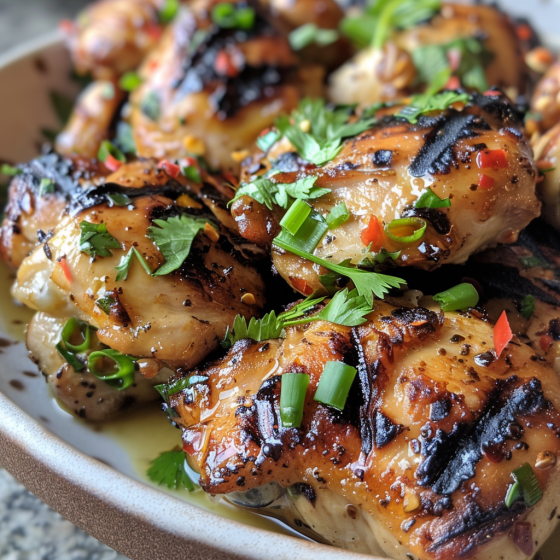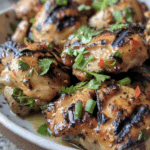Vietnamese cuisine is celebrated worldwide for its vibrant flavors, fresh ingredients, and exquisite balance of herbs and spices. One standout dish that embodies these characteristics is Grilled Vietnamese Lemongrass Chicken. This recipe offers a delightful mix of tangy, sweet, and savory flavors, making it a perfect choice for a family meal or a festive gathering. Below, we provide a step-by-step guide on how to prepare this aromatic and delicious dish, complete with tips for achieving the perfect grilled chicken.
Ingredients:
- 4 boneless, skinless chicken thighs or breasts
- 3 stalks of lemongrass, finely minced
- 4 cloves garlic, minced
- 1 large shallot, minced
- 2 tablespoons soy sauce
- 1 tablespoon fish sauce
- 2 tablespoons brown sugar or honey
- 1 tablespoon lime juice
- 2 tablespoons vegetable oil
- Freshly ground black pepper
- Optional garnish: fresh cilantro, sliced chili, and lime wedges
Instructions:

- Prepare the Marinade:
- Begin by preparing the lemongrass. Remove the tough outer layers and finely mince the softer, lighter-colored part of the stalks.
- In a mixing bowl, combine the minced lemongrass with garlic, shallots, soy sauce, fish sauce, brown sugar (or honey), lime juice, and vegetable oil. Stir well to ensure all the sugar has dissolved and the ingredients are thoroughly mixed.
- Marinate the Chicken:
- Place the chicken thighs or breasts in a large bowl or resealable plastic bag. Pour the marinade over the chicken, making sure each piece is evenly coated.
- Allow the chicken to marinate in the refrigerator for at least 1 hour, though for best results, leaving it overnight will enhance the flavors significantly.
- Prepare the Grill:
- Preheat your grill to medium-high heat. Ensure the grill grates are clean and lightly oiled to prevent the chicken from sticking.
- Grill the Chicken:
- Remove the chicken from the marinade, shaking off excess liquid. Place the chicken on the grill and cook for 6-7 minutes on each side, or until the chicken is thoroughly cooked and has nice grill marks.
- An internal temperature of 165°F (74°C) is recommended for chicken to be fully cooked.
- Serving:
- Let the chicken rest for a few minutes after grilling. This helps in retaining the juices when sliced.
- Slice the chicken and serve on a platter, garnished with cilantro, slices of chili, and lime wedges if desired. It pairs wonderfully with steamed rice or rice noodles and a side of fresh vegetables.
Tips for Perfect Grilled Vietnamese Lemongrass Chicken:
- Marinating Time: To infuse the chicken with the aromatic flavors of lemongrass and other ingredients, marinate it for as long as possible, preferably overnight.
- Grill Temperature: Keep the grill at a consistent medium-high temperature to ensure the chicken cooks evenly without burning.
- Internal Temperature: Always check the internal temperature of your chicken to avoid undercooked poultry. A meat thermometer is handy for this purpose.
Conclusion:
Grilled Vietnamese Lemongrass Chicken is not just a meal; it’s a journey through the rich culinary landscape of Vietnam. This dish is both easy to prepare and irresistibly flavorful, offering a perfect example of how simple ingredients can create profound tastes. Whether you are new to Vietnamese cooking or looking to add a new recipe to your grilling repertoire, this lemongrass chicken promises to satisfy your cravings for exotic flavors and robust aromas. Enjoy the culinary adventure!
Serving and Storage Tips for Grilled Vietnamese Lemongrass Chicken
Grilled Vietnamese Lemongrass Chicken is a delightful dish that’s perfect for various occasions. To make the most out of your culinary effort, here are some essential tips on how to serve and store this flavorful meal.
Serving Tips:
- Accompaniments: Serve the Grilled Vietnamese Lemongrass Chicken with complementary sides that balance the flavors. Steamed jasmine or basmati rice, rice noodles, or a fresh salad with cucumbers, carrots, and a light vinaigrette work wonderfully. These sides help soak up the marinade’s flavor and make for a fuller meal.
- Add Freshness: Garnish with fresh herbs like cilantro, mint, or basil right before serving. The freshness of these herbs contrasts beautifully with the grilled, smoky flavor of the chicken. Additionally, offer lime wedges and sliced chili for guests to adjust their dish’s acidity and heat to their liking.
- Presentation: Present the chicken on a platter with the garnishes attractively placed around it. A visually appealing dish enhances the eating experience and highlights the fresh ingredients used in Vietnamese cuisine.
Storage Tips:
- Cooling Down: Allow the chicken to cool to room temperature before storing to prevent moisture buildup and bacterial growth. However, don’t leave it out for more than two hours to ensure it remains safe to eat.
- Refrigeration: Place the grilled chicken in an airtight container or wrap it tightly with plastic wrap or aluminum foil. Refrigerated properly, the chicken can last for up to 3-4 days. Ensure your refrigerator’s temperature is set below 40°F (4°C).
- Freezing: For longer storage, Grilled Vietnamese Lemongrass Chicken freezes well. Slice the cooked chicken (if not already done so), and wrap each piece individually in freezer-safe wrap or place them in airtight freezer bags. Properly stored, the chicken can be kept frozen for up to 2 months. Label the bags with the date to keep track of storage time.
- Reheating: When ready to eat, thaw the chicken in the refrigerator if frozen. Reheat on a stove over medium heat or in a microwave, using a microwave-safe dish until heated thoroughly. If using a microwave, cover the dish to retain moisture. To regain a bit of the original texture, briefly grill or broil the chicken after heating to add some crispness and revive the grilled flavor.
Following these serving and storage tips will help you enjoy your Grilled Vietnamese Lemongrass Chicken at its best, whether freshly made or as a delicious leftover.
1. What part of the lemongrass should I use for this recipe?
For the best flavor, use the lower part of the lemongrass stalk. Remove the tough outer layers and use only the tender, pale yellow part near the root. This section is more flavorful and less fibrous, making it ideal for mincing and incorporating into the marinade.
2. Can I use chicken breasts instead of thighs for this recipe?
Absolutely! Chicken breasts can be used as a leaner alternative to thighs. Keep in mind that breasts are less fatty and might dry out if overcooked, so monitoring the grill time and temperature is crucial. Consider marinating the chicken breasts for a longer period to ensure they absorb enough flavor and retain moisture during cooking.
3. How can I make this dish if I don’t have a grill?
If you don’t have a grill, you can still enjoy this recipe by using a grill pan or broiler. To use a grill pan, heat it over medium-high heat and cook the chicken as directed. If broiling, place the chicken on a broiler pan and broil 4-6 inches from the heat source, following similar cooking times as grilling. Both methods will give you a delicious result, although the smoky flavor from outdoor grilling might be less pronounced.
4. What are some vegetarian alternatives I can use with the same marinade?
The lemongrass marinade used in this recipe is also excellent with tofu, tempeh, or vegetables. For a vegetarian version, press and slice firm tofu, marinate for at least one hour or overnight, and grill until each side is golden and crispy. You can also use the marinade for vegetables like bell peppers, zucchini, and mushrooms. Grill the marinated vegetables or bake them for a delightful side dish or vegetarian main course.

Grilled Vietnamese Lemongrass Chicken
- Prep Time: 10 minutes
- Cook Time: 15 minutes
- Total Time: 25 minutes (plus marinating time)
- Yield: 4 servings 1x
- Category: Main Course
- Method: Grilling
- Cuisine: Vietnamese
- Diet: Halal
Description
Grilled Vietnamese Lemongrass Chicken is a fragrant and savory dish featuring chicken marinated in a blend of lemongrass, garlic, fish sauce, and spices. Grilled to perfection, it’s juicy, aromatic, and perfect with rice or noodles.
Ingredients
- 1.5 pounds boneless, skinless chicken thighs
- 3 stalks lemongrass, white part only, finely minced
- 3 cloves garlic, minced
- 2 tablespoons fish sauce
- 1 tablespoon soy sauce
- 1 tablespoon brown sugar
- 1 tablespoon vegetable oil
- 1 teaspoon ground black pepper
- 1 tablespoon lime juice
- Fresh herbs (cilantro, mint), for garnish
- Lime wedges, for serving
Instructions
- In a bowl, mix lemongrass, garlic, fish sauce, soy sauce, brown sugar, oil, black pepper, and lime juice.
- Add chicken thighs and toss to coat. Cover and marinate in the fridge for at least 1 hour, preferably overnight.
- Preheat grill to medium-high heat. Lightly oil the grates.
- Grill chicken for 5–7 minutes per side, or until nicely charred and internal temperature reaches 165°F (74°C).
- Let rest for 5 minutes, then slice and serve with rice, noodles, or salad.
- Garnish with fresh herbs and lime wedges.
Notes
- Use a food processor to finely mince lemongrass for best flavor and texture.
- Also works well with chicken breasts or wings.
- Leftovers make great rice bowls or banh mi sandwiches.
Nutrition
- Serving Size: 1/4 of recipe
- Calories: 310
- Sugar: 4g
- Sodium: 710mg
- Fat: 20g
- Saturated Fat: 5g
- Unsaturated Fat: 13g
- Trans Fat: 0g
- Carbohydrates: 6g
- Fiber: 0g
- Protein: 26g
- Cholesterol: 135mg
